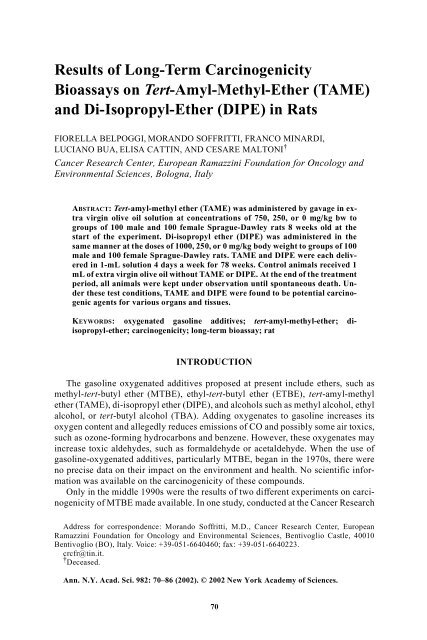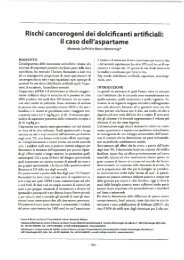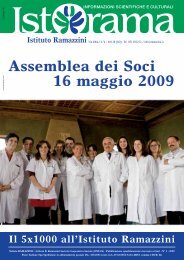Results of Long-Term Carcinogenicity Bioassays on Tert-Amyl ...
Results of Long-Term Carcinogenicity Bioassays on Tert-Amyl ...
Results of Long-Term Carcinogenicity Bioassays on Tert-Amyl ...
You also want an ePaper? Increase the reach of your titles
YUMPU automatically turns print PDFs into web optimized ePapers that Google loves.
<str<strong>on</strong>g>Results</str<strong>on</strong>g> <str<strong>on</strong>g>of</str<strong>on</strong>g> <str<strong>on</strong>g>L<strong>on</strong>g</str<strong>on</strong>g>-<str<strong>on</strong>g>Term</str<strong>on</strong>g> <str<strong>on</strong>g>Carcinogenicity</str<strong>on</strong>g><br />
<str<strong>on</strong>g>Bioassays</str<strong>on</strong>g> <strong>on</strong> <strong>Tert</strong>-<strong>Amyl</strong>-Methyl-Ether (TAME)<br />
and Di-Isopropyl-Ether (DIPE) in Rats<br />
FIORELLA BELPOGGI, MORANDO SOFFRITTI, FRANCO MINARDI,<br />
LUCIANO BUA, ELISA CATTIN, AND CESARE MALTONI †<br />
Cancer Research Center, European Ramazzini Foundati<strong>on</strong> for Oncology and<br />
Envir<strong>on</strong>mental Sciences, Bologna, Italy<br />
ABSTRACT: <strong>Tert</strong>-amyl-methyl ether (TAME) was administered by gavage in extra<br />
virgin olive oil soluti<strong>on</strong> at c<strong>on</strong>centrati<strong>on</strong>s <str<strong>on</strong>g>of</str<strong>on</strong>g> 750, 250, or 0 mg/kg bw to<br />
groups <str<strong>on</strong>g>of</str<strong>on</strong>g> 100 male and 100 female Sprague-Dawley rats 8 weeks old at the<br />
start <str<strong>on</strong>g>of</str<strong>on</strong>g> the experiment. Di-isopropyl ether (DIPE) was administered in the<br />
same manner at the doses <str<strong>on</strong>g>of</str<strong>on</strong>g> 1000, 250, or 0 mg/kg body weight to groups <str<strong>on</strong>g>of</str<strong>on</strong>g> 100<br />
male and 100 female Sprague-Dawley rats. TAME and DIPE were each delivered<br />
in 1-mL soluti<strong>on</strong> 4 days a week for 78 weeks. C<strong>on</strong>trol animals received 1<br />
mL <str<strong>on</strong>g>of</str<strong>on</strong>g> extra virgin olive oil without TAME or DIPE. At the end <str<strong>on</strong>g>of</str<strong>on</strong>g> the treatment<br />
period, all animals were kept under observati<strong>on</strong> until sp<strong>on</strong>taneous death. Under<br />
these test c<strong>on</strong>diti<strong>on</strong>s, TAME and DIPE were found to be potential carcinogenic<br />
agents for various organs and tissues.<br />
KEYWORDS: oxygenated gasoline additives; tert-amyl-methyl-ether; diisopropyl-ether;<br />
carcinogenicity; l<strong>on</strong>g-term bioassay; rat<br />
INTRODUCTION<br />
The gasoline oxygenated additives proposed at present include ethers, such as<br />
methyl-tert-butyl ether (MTBE), ethyl-tert-butyl ether (ETBE), tert-amyl-methyl<br />
ether (TAME), di-isopropyl ether (DIPE), and alcohols such as methyl alcohol, ethyl<br />
alcohol, or tert-butyl alcohol (TBA). Adding oxygenates to gasoline increases its<br />
oxygen c<strong>on</strong>tent and allegedly reduces emissi<strong>on</strong>s <str<strong>on</strong>g>of</str<strong>on</strong>g> CO and possibly some air toxics,<br />
such as oz<strong>on</strong>e-forming hydrocarb<strong>on</strong>s and benzene. However, these oxygenates may<br />
increase toxic aldehydes, such as formaldehyde or acetaldehyde. When the use <str<strong>on</strong>g>of</str<strong>on</strong>g><br />
gasoline-oxygenated additives, particularly MTBE, began in the 1970s, there were<br />
no precise data <strong>on</strong> their impact <strong>on</strong> the envir<strong>on</strong>ment and health. No scientific informati<strong>on</strong><br />
was available <strong>on</strong> the carcinogenicity <str<strong>on</strong>g>of</str<strong>on</strong>g> these compounds.<br />
Only in the middle 1990s were the results <str<strong>on</strong>g>of</str<strong>on</strong>g> two different experiments <strong>on</strong> carcinogenicity<br />
<str<strong>on</strong>g>of</str<strong>on</strong>g> MTBE made available. In <strong>on</strong>e study, c<strong>on</strong>ducted at the Cancer Research<br />
Address for corresp<strong>on</strong>dence: Morando S<str<strong>on</strong>g>of</str<strong>on</strong>g>fritti, M.D., Cancer Research Center, European<br />
Ramazzini Foundati<strong>on</strong> for Oncology and Envir<strong>on</strong>mental Sciences, Bentivoglio Castle, 40010<br />
Bentivoglio (BO), Italy. Voice: +39-051-6640460; fax: +39-051-6640223.<br />
crcfr@tin.it.<br />
† Deceased.<br />
Ann. N.Y. Acad. Sci. 982: 70–86 (2002). © 2002 New York Academy <str<strong>on</strong>g>of</str<strong>on</strong>g> Sciences.<br />
70
BELPOGGI et al.: CARCINOGENICITY OF TAME AND DIPE<br />
Center <str<strong>on</strong>g>of</str<strong>on</strong>g> the Ramazzini Foundati<strong>on</strong> (CRC/RF), MTBE was shown to cause an increase<br />
in lymphomas/leukemias (mainly due to lymphoimmunoblastic lymphomas)<br />
in female Sprague-Dawley rats and an increase in interstitial cell adenomas <str<strong>on</strong>g>of</str<strong>on</strong>g> the<br />
testis in male rats. 1–3 Another study, sp<strong>on</strong>sored by producers and users <str<strong>on</strong>g>of</str<strong>on</strong>g> MTBE,<br />
found that MTBE caused an increase in hepatocellular adenoma in female CD-1 mice<br />
and an increase in renal tubular adenomas and carcinomas in male Fisher 344 rats. 4,5<br />
In recent years, great c<strong>on</strong>cern has arisen regarding the use <str<strong>on</strong>g>of</str<strong>on</strong>g> MTBE because <str<strong>on</strong>g>of</str<strong>on</strong>g><br />
groundwater c<strong>on</strong>taminati<strong>on</strong> associated with gasoline spills and leaks from underground<br />
storage tanks 6 and complaints <str<strong>on</strong>g>of</str<strong>on</strong>g> people exposed to MTBE from such sources,<br />
complaining <str<strong>on</strong>g>of</str<strong>on</strong>g> unpleasant odor, headaches, and burning <str<strong>on</strong>g>of</str<strong>on</strong>g> the eyes and throat. 7<br />
Because <str<strong>on</strong>g>of</str<strong>on</strong>g> MTBE’s toxic effects, carcinogenic potential, air polluti<strong>on</strong>, and c<strong>on</strong>taminati<strong>on</strong><br />
<str<strong>on</strong>g>of</str<strong>on</strong>g> the water supply, the petroleum industry has had to propose other<br />
oxygenated additives as alternative oxygenated gasoline additives.<br />
In the 1980s, in the c<strong>on</strong>text <str<strong>on</strong>g>of</str<strong>on</strong>g> our research program <strong>on</strong> the carcinogenicity <str<strong>on</strong>g>of</str<strong>on</strong>g><br />
fuels, a systematic and integrated project <str<strong>on</strong>g>of</str<strong>on</strong>g> experimental carcinogenicity bioassay<br />
was started <strong>on</strong> various gasoline additives, namely, the oxygenated additives methyl<br />
alcohol, ethyl alcohol, MTBE, ETBE, TAME, DIPE, and the isoparaffin, 2,2,4-trimethyl<br />
pentane (TMP). The experiments were performed <strong>on</strong> Sprague-Dawley rats<br />
from the CRC/RF col<strong>on</strong>y <strong>on</strong> which there is abundant informati<strong>on</strong> regarding expected<br />
pathology from historical c<strong>on</strong>trols. The final results <str<strong>on</strong>g>of</str<strong>on</strong>g> the experiments <strong>on</strong> MTBE<br />
and ETBE have already been published, 1–3,8 and those <strong>on</strong> methyl alcohol and ethyl<br />
alcohol are reported in this volume. This report outlines the final results <str<strong>on</strong>g>of</str<strong>on</strong>g> the carcinogenicity<br />
bioassays <strong>on</strong> TAME and DIPE.<br />
<strong>Tert</strong>-amyl-methyl ether (TAME) is a colorless, flammable liquid. TAME<br />
(C 6 H 14 O) has a molecular weight <str<strong>on</strong>g>of</str<strong>on</strong>g> 102.18. Di-isopropyl ether (DIPE) is a colorless,<br />
flammable liquid with a sharp, sweet, ether-like odor. DIPE (C 6 H 14 O) has a<br />
molecular weight <str<strong>on</strong>g>of</str<strong>on</strong>g> 102.18.<br />
TAME is manufactured from isoamylene and methanol feedstocks. The principal<br />
source <str<strong>on</strong>g>of</str<strong>on</strong>g> isoamylene is the C5-olefin stream from a crude oil-refining process called<br />
fluid catalytic cracking. TAME manufacturing provides a refinery with a way to reduce<br />
the gasoline vapor pressure, reduce the light olefin c<strong>on</strong>tent <str<strong>on</strong>g>of</str<strong>on</strong>g> gasoline, and create<br />
a high octane gasoline-blending comp<strong>on</strong>ent. However, similar benefits could<br />
also be obtained by using the C5-olefins in the refinery’s hydrocarb<strong>on</strong> alkylati<strong>on</strong><br />
process. 9 DIPE is commercially prepared by the acti<strong>on</strong> <str<strong>on</strong>g>of</str<strong>on</strong>g> sulfuric acid <strong>on</strong> isopropyl<br />
alcohol and also obtained as a by-product in the producti<strong>on</strong> <str<strong>on</strong>g>of</str<strong>on</strong>g> isopropyl alcohol<br />
from the propylene fracti<strong>on</strong> <str<strong>on</strong>g>of</str<strong>on</strong>g> cracked gasoline. 10 The world producti<strong>on</strong> capacity <str<strong>on</strong>g>of</str<strong>on</strong>g><br />
DIPE is unknown but likely to be small. In the United States, it is a permitted additive<br />
under U.S. Federal reformulated gasoline regulati<strong>on</strong>s. 11<br />
The informati<strong>on</strong> <strong>on</strong> toxicity, mutagenicity, and carcinogenicity <strong>on</strong> TAME is<br />
extremely limited. 12<br />
MATERIAL AND METHODS<br />
TAME and DIPE were supplied by SIGMA-ALDRICH, Divisi<strong>on</strong> <str<strong>on</strong>g>of</str<strong>on</strong>g> SAF Bulk<br />
Chemicals, Milan, Italy, and their purity was higher than 97% and 98%, respectively.<br />
The extra virgin oil used as a carrier was provided by Oliaria Toscana (the same oil<br />
used in the CRC/RF laboratory for 25 years).<br />
71
TABLE 1. <str<strong>on</strong>g>L<strong>on</strong>g</str<strong>on</strong>g>-term carcinogenicity bioassays <strong>on</strong> tert-amyl-methyl ether (TAME) administered by gavage to male (M) and female (F)<br />
Sprague-Dawley rats<br />
— C<strong>on</strong>tinued<br />
72 ANNALS NEW YORK ACADEMY OF SCIENCES
TABLE 1. C<strong>on</strong>tinued<br />
BELPOGGI et al.: CARCINOGENICITY OF TAME AND DIPE<br />
73<br />
— C<strong>on</strong>tinued
TABLE 1. C<strong>on</strong>tinued<br />
74 ANNALS NEW YORK ACADEMY OF SCIENCES<br />
— C<strong>on</strong>tinued
TABLE 1. C<strong>on</strong>tinued<br />
BELPOGGI et al.: CARCINOGENICITY OF TAME AND DIPE<br />
75
76 ANNALS NEW YORK ACADEMY OF SCIENCES<br />
TABLE 2. <str<strong>on</strong>g>L<strong>on</strong>g</str<strong>on</strong>g>-term carcinogenicity bioassays <strong>on</strong> tert-amyl-methyl ether (TAME)<br />
administered by gavage to male (M) and female (F) Sprague-Dawley rats<br />
During experiments, compounds TAME and DIPE were stored at 4°C. TAME was<br />
administered by gavage in 1 mL extra virgin olive oil soluti<strong>on</strong> at c<strong>on</strong>centrati<strong>on</strong>s <str<strong>on</strong>g>of</str<strong>on</strong>g><br />
750, 250, or 0 mg/kg bw to groups <str<strong>on</strong>g>of</str<strong>on</strong>g> 100 male and 100 female Sprague-Dawley rats<br />
8 weeks old at the start <str<strong>on</strong>g>of</str<strong>on</strong>g> the experiment. TAME was administered daily, 4 days<br />
weekly, for 78 weeks. The animals were then maintained under c<strong>on</strong>trol c<strong>on</strong>diti<strong>on</strong>s<br />
until sp<strong>on</strong>taneous death. C<strong>on</strong>trol animals received 1 mL <str<strong>on</strong>g>of</str<strong>on</strong>g> extra virgin olive oil without<br />
TAME. The experiment began in February 1995 and ended after 135 weeks <str<strong>on</strong>g>of</str<strong>on</strong>g><br />
treatment with the death <str<strong>on</strong>g>of</str<strong>on</strong>g> the last animal at 143 weeks <str<strong>on</strong>g>of</str<strong>on</strong>g> age. Testing <str<strong>on</strong>g>of</str<strong>on</strong>g> DIPE was<br />
c<strong>on</strong>current with that <str<strong>on</strong>g>of</str<strong>on</strong>g> TAME, and the experimental protocols were identical, apart<br />
from the higher dose level <str<strong>on</strong>g>of</str<strong>on</strong>g> DIPE (1000 mg/kg body weight). The DIPE experiment<br />
ended after 163 weeks <str<strong>on</strong>g>of</str<strong>on</strong>g> treatment with the death <str<strong>on</strong>g>of</str<strong>on</strong>g> the last animal at 171 weeks <str<strong>on</strong>g>of</str<strong>on</strong>g><br />
age. Both experiments were performed according to Good Laboratory Practices<br />
(GLP) and Standard Operating Procedure (SOP) <str<strong>on</strong>g>of</str<strong>on</strong>g> the CRC/RF.<br />
The experimental c<strong>on</strong>diti<strong>on</strong>s, protocol, and histopathology are described in detail<br />
elsewhere in this volume. 13 Multiple tumors <str<strong>on</strong>g>of</str<strong>on</strong>g> different type and site, <str<strong>on</strong>g>of</str<strong>on</strong>g> different<br />
type in the same site, <str<strong>on</strong>g>of</str<strong>on</strong>g> the same type in bilateral organs, <str<strong>on</strong>g>of</str<strong>on</strong>g> the same type in the<br />
skin, subcutaneous tissue, and mammary glands, or at distant sites <str<strong>on</strong>g>of</str<strong>on</strong>g> diffuse tissue<br />
(i.e., b<strong>on</strong>es, skeletal muscle, etc.) were plotted as single/independent tumors. Multiple<br />
tumors <str<strong>on</strong>g>of</str<strong>on</strong>g> the same type in the same tissue and organ, including the bilateral organs,<br />
were plotted <strong>on</strong>ly <strong>on</strong>ce. Statistical analysis was performed using the χ 2 test to<br />
evaluate differences in tumor incidence between treated and c<strong>on</strong>trol groups. The Cochrane<br />
Armitage test was used to evaluate dose-resp<strong>on</strong>se relati<strong>on</strong>ships.
TABLE 3. <str<strong>on</strong>g>L<strong>on</strong>g</str<strong>on</strong>g>-term carcinogenicity bioassays <strong>on</strong> tert-amyl-methyl ether (TAME) administered by gavage to male (M) and female (F)<br />
Sprague-Dawley rats<br />
BELPOGGI et al.: CARCINOGENICITY OF TAME AND DIPE<br />
77
TABLE 4. <str<strong>on</strong>g>L<strong>on</strong>g</str<strong>on</strong>g>-term carcinogenicity bioassays <strong>on</strong> di-isopropyl (DIPE)) administered by gavage to male (M) and female (F)<br />
Sprague-Dawley rats<br />
— C<strong>on</strong>tinued<br />
78 ANNALS NEW YORK ACADEMY OF SCIENCES
BELPOGGI et al.: CARCINOGENICITY OF TAME AND DIPE<br />
TABLE 4. C<strong>on</strong>tinued<br />
79<br />
— C<strong>on</strong>tinued
80 ANNALS NEW YORK ACADEMY OF SCIENCES<br />
TABLE 4. C<strong>on</strong>tinued<br />
— C<strong>on</strong>tinued
BELPOGGI et al.: CARCINOGENICITY OF TAME AND DIPE<br />
TABLE 4. C<strong>on</strong>tinued<br />
— C<strong>on</strong>tinued<br />
81
TABLE 4. C<strong>on</strong>tinued<br />
a Between brackets the number <str<strong>on</strong>g>of</str<strong>on</strong>g> tumors (<strong>on</strong>e animal can bear more than <strong>on</strong>e tumor). b Olive oil al<strong>on</strong>e. c In 96% <str<strong>on</strong>g>of</str<strong>on</strong>g> cases the tumor itself is composed <str<strong>on</strong>g>of</str<strong>on</strong>g> a<br />
mixture in varying proporti<strong>on</strong>s <str<strong>on</strong>g>of</str<strong>on</strong>g> epithelial cells and lymphocytes. In the remaining 4%, <strong>on</strong>ly epithelial cells are present. We c<strong>on</strong>sider that a tumor composed<br />
exclusively <str<strong>on</strong>g>of</str<strong>on</strong>g> lymphocytes should not be classified as a thymoma but as a lymphoma involving the thymus. d Including thymus, spleen and subcutaneous<br />
lymph nodes. e See TABLES 6.<br />
82 ANNALS NEW YORK ACADEMY OF SCIENCES
TABLE 5. <str<strong>on</strong>g>L<strong>on</strong>g</str<strong>on</strong>g>-term carcinogenicity bioassays <strong>on</strong> di-isopropyl ether (DIPE))<br />
administered by gavage to male (M) and female (F) Sprague-Dawley rats<br />
BELPOGGI et al.: CARCINOGENICITY OF TAME AND DIPE<br />
83
TABLE 6. <str<strong>on</strong>g>L<strong>on</strong>g</str<strong>on</strong>g>-term carcinogenicity bioassays <strong>on</strong> di-isopropyl ether (DIPE)) administered by gavage to male (M) and female (F) Sprague-<br />
Dawley rats<br />
84 ANNALS NEW YORK ACADEMY OF SCIENCES
BELPOGGI et al.: CARCINOGENICITY OF TAME AND DIPE<br />
RESULTS<br />
No significant differences were observed in daily water or feed c<strong>on</strong>sumpti<strong>on</strong>,<br />
body weight, behavior, or treatment-related n<strong>on</strong><strong>on</strong>cological pathological changes<br />
between TAME- or DIPE-treated and c<strong>on</strong>trol animals. In the period between the 40th<br />
and 104th week <str<strong>on</strong>g>of</str<strong>on</strong>g> age, a decrease in survival was observed in TAME-treated males<br />
compared to c<strong>on</strong>trols. A decrease in survival was observed in DIPE-treated males<br />
versus c<strong>on</strong>trols in the period between the 56th and 88th week <str<strong>on</strong>g>of</str<strong>on</strong>g> age.<br />
The occurrence <str<strong>on</strong>g>of</str<strong>on</strong>g> benign and malignant tumors in TAME-treated and c<strong>on</strong>trol animalsisshowninTABLE<br />
1. Significant findings in TAME-treated and c<strong>on</strong>trol animals<br />
are summarized as follows: (1) no differences were observed in the total<br />
number <str<strong>on</strong>g>of</str<strong>on</strong>g> malignant tumors (TABLE 2); (2) increases in some sporadic malignant tumors<br />
<str<strong>on</strong>g>of</str<strong>on</strong>g> the gastrointestinal tract occurred in males and females treated with the lower<br />
dose compared to the c<strong>on</strong>trol group; (3) an increased incidence <str<strong>on</strong>g>of</str<strong>on</strong>g> ear duct<br />
carcinomas was noted in treated males and females compared to c<strong>on</strong>trol animals; (4)<br />
an increase in the incidence <str<strong>on</strong>g>of</str<strong>on</strong>g> interstitial cell adenomas <str<strong>on</strong>g>of</str<strong>on</strong>g> the testis was observed<br />
in treated animals; (5) an increase in the incidence <str<strong>on</strong>g>of</str<strong>on</strong>g> glial malignant tumors <str<strong>on</strong>g>of</str<strong>on</strong>g> the<br />
brain was noted in males treated at both doses; and (6) an increase in the incidence<br />
<str<strong>on</strong>g>of</str<strong>on</strong>g> hemolymphoreticular neoplasias in males treated at the highest dose and in females<br />
treated at both doses (TABLE 3).<br />
The occurrence <str<strong>on</strong>g>of</str<strong>on</strong>g> benign and malignant tumors in DIPE-treated and c<strong>on</strong>trol animalsisshowninTABLE<br />
4. Significant findings in DIPE-treated and c<strong>on</strong>trol animals<br />
are summarized as follows: (1) an increase in total malignant tumors was observed<br />
in males and females <str<strong>on</strong>g>of</str<strong>on</strong>g> both treated groups (TABLE 5); (2) an increase in the incidence<br />
<str<strong>on</strong>g>of</str<strong>on</strong>g> carcinomas <str<strong>on</strong>g>of</str<strong>on</strong>g> the ear duct occurred in males treated at 1,000 and 250 mg/<br />
kg bw (P
86 ANNALS NEW YORK ACADEMY OF SCIENCES<br />
ACKNOWLEDGMENTS<br />
This research was partially supported by the Regi<strong>on</strong>al Agency for Preventi<strong>on</strong> and<br />
Envir<strong>on</strong>ment (Agenzia Regi<strong>on</strong>ale Prevenzi<strong>on</strong>e e Ambiente, ARPA) <str<strong>on</strong>g>of</str<strong>on</strong>g> the Emilia-<br />
Romagna Regi<strong>on</strong>, Italy<br />
REFERENCES<br />
1. BELPOGGI, F.et al. 1995. Methyl-tertiary-butyl ether (MTBE), a gasoline additive,<br />
causes testicular and lymphohaematopoietic cancers in rats. Toxicol. Ind. Health 11:<br />
119–149.<br />
2. BELPOGGI, F.et al. 1997. <str<strong>on</strong>g>Results</str<strong>on</strong>g> <str<strong>on</strong>g>of</str<strong>on</strong>g> l<strong>on</strong>g-term experimental studies <strong>on</strong> the carcinogenicity<br />
<str<strong>on</strong>g>of</str<strong>on</strong>g> methyl-tert-butyl ether. Ann. N.Y. Acad. Sci. 837: 77–95.<br />
3. BELPOGGI, F.et al. 1998. Pathological characterizati<strong>on</strong> <str<strong>on</strong>g>of</str<strong>on</strong>g> testicular tumours and lymphomas-leukaemias,<br />
and <str<strong>on</strong>g>of</str<strong>on</strong>g> their precursors observed in Sprague-Dawley rats<br />
exposed to methyl-tertiary-butyl-ether (MTBE). Eur. J. Oncol. 3: 201–206.<br />
4. BURLEIGH-FLAYER, H.D. et al. 1992. Methyl-tertiary-butyl ether: vapor inhalati<strong>on</strong><br />
<strong>on</strong>cogenicity study in CD-1 mice. BRRC report 91N0013A. Uni<strong>on</strong> Carbide, Bushy<br />
Run Research Center, Export, PA.<br />
5. CHUN, J.S. et al. 1992. Methyl-tertiary-butyl ether: vapor inhalati<strong>on</strong> <strong>on</strong>cogenicity<br />
study in Fisher-344 rats. BRRC report 91N0013B. Uni<strong>on</strong> Carbide, Bushy Run<br />
Research Center, Export, PA.<br />
6. SQUILLACE, P.J.et al. 1996. Preliminary assessment <str<strong>on</strong>g>of</str<strong>on</strong>g> the occurrence and possible<br />
sources <str<strong>on</strong>g>of</str<strong>on</strong>g> MTBE in groundwater in the United States, 1993-1994. Envir<strong>on</strong>. Sci.<br />
Technol. 30: 227–233.<br />
7. MEHLMAN, M.A. 2001. Methyl-tertiary-butyl-ether (MTBE) misclassified. Am. J. Ind.<br />
Med. 39: 505-508.<br />
8. MALTONI, C.et al. 1999. Comprehensive l<strong>on</strong>g-term experimental project <str<strong>on</strong>g>of</str<strong>on</strong>g> carcinogenicity<br />
bioassays <strong>on</strong> gasoline oxygenated additives: plan and first report <str<strong>on</strong>g>of</str<strong>on</strong>g> results<br />
from the study <strong>on</strong> ethyl-tertiary butyl ether (ETBE). Eur. J. Oncol. 4: 493–508.<br />
9. WITHE, R.D.et al. 1995. Health effects <str<strong>on</strong>g>of</str<strong>on</strong>g> inhaled tertiary amyl methyl ether and ethyl<br />
tertiary butyl ether. Toxicol. Lett. (Elsevier Science Ireland) 82/83: 719–724.<br />
10. PATTY, F.A. 1963. Industrial Hygiene and Toxicology, 2nd edit., revised. Vol. II. Toxicology.<br />
Interscience Publishers, Wiley & S<strong>on</strong>s, Inc. New York.<br />
11. ZOGORSKI, J.S.et al. 1996. Fuel Oxygenate and Water Quality: Current Understanding<br />
<str<strong>on</strong>g>of</str<strong>on</strong>g> Sources, Occurrence in Natural Waters, Envir<strong>on</strong>mental Behavior, Fate, and Significance.<br />
U.S. Geological Survey. Rapid City, South Dakota.<br />
12. FROINES, J.R.et al. 1998. An Evaluati<strong>on</strong> <str<strong>on</strong>g>of</str<strong>on</strong>g> the Scientific Peer-Reviewed Research and<br />
Literature <strong>on</strong> the Human Health Effects <str<strong>on</strong>g>of</str<strong>on</strong>g> MTBE, its Metabolites, Combusti<strong>on</strong><br />
Products and Substitute Compounds. Report to the Legislature <str<strong>on</strong>g>of</str<strong>on</strong>g> the State <str<strong>on</strong>g>of</str<strong>on</strong>g> California.Vol.II.:179.HumanHealthEffects.<br />
13. SOFFRITTI, M.et al. 2002. <str<strong>on</strong>g>Results</str<strong>on</strong>g> <str<strong>on</strong>g>of</str<strong>on</strong>g> l<strong>on</strong>g-term experimental studies <strong>on</strong> the carcinogenicity<br />
<str<strong>on</strong>g>of</str<strong>on</strong>g> methyl alcohol and ethyl alcohol in rats. Ann. N.Y. Acad. Sci. 982: this<br />
volume.










